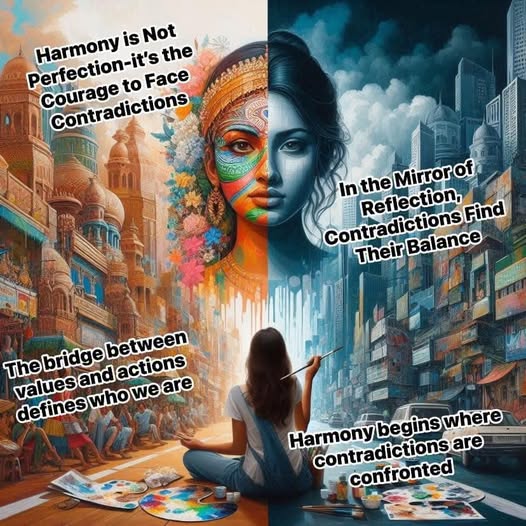
Once upon a time, in a bustling city at the crossroads of tradition and modernity, there lived a young woman named Amara. She was known far and wide as a thinker and a speaker, someone whose eloquence could inspire entire crowds. Her words were often laced with ideals of justice, sustainability, and the preservation of culture. Yet, as fate would have it, her life became a symphony of contradictions that began to play louder with every passing year.
Amara often graced the grand halls of cultural forums, where she passionately argued for the preservation of her city’s ancient landmarks. “These monuments,” she would declare, “are the soul of our heritage, a testament to the ingenuity and resilience of our ancestors. To lose them is to lose a part of ourselves.” Her speeches earned her admiration and applause, painting her as a steward of history.
But in another setting, seated in a sleek boardroom overlooking the very same city, Amara wore a different hat. As a rising executive in a real estate firm, she advocated for cost-efficient urban expansion. One day, when her firm proposed demolishing an old, crumbling theater to make way for a commercial plaza, she hesitated for a moment. Then, reasoning that the city needed economic growth more than nostalgia, she signed the approval papers. That ancient theater, with its faded murals and cracked marble floors, became dust under the weight of modern glass towers.
Amara’s contradictions did not end there. At climate conferences, she spoke passionately about the urgency of addressing climate change. “We must act now,” she urged, “to protect this fragile planet for future generations. Every decision we make today will echo into eternity.” Yet, at the same time, she lobbied her government for a new manufacturing plant in her district—a project that promised thousands of jobs but would significantly increase carbon emissions. In those moments, she justified her stance as pragmatism, whispering to herself that “people need jobs first; the environment can wait.”
Then came the most poignant chapter of her journey. Amara, a fervent human rights advocate, championed policies for equality and inclusion. She had marched in protests, spoken in courts, and written impassioned articles about the dignity of every human life. But when whispers of a looming conflict at her nation’s borders grew louder, she found herself supporting stringent immigration policies and endorsing military actions. “It’s about protecting our people,” she reasoned, her voice quieter than before.
One fateful evening, a chance encounter with a mysterious elderly man shifted the course of her life. Amara was walking home after a long day of negotiations, her mind a whirlwind of justifications and compromises. She passed by an old park bench, where the man sat beneath a flickering lamppost. His white hair glowed faintly in the light, and his eyes seemed to hold the weight of centuries.
“You look troubled,” he said softly.
Amara paused, surprised by his perception. “Just tired,” she replied.
“Or perhaps,” he said with a knowing smile, “you’re wrestling with contradictions.”
The words hit her like a wave. She froze, her thoughts unraveling. “What do you mean?”
He gestured to the lamppost above them. “Look at that light. It stands firm, illuminating the path. But if its bulb flickers, unsure of its purpose, it fails to guide anyone.”
Amara sank onto the bench beside him, her defenses crumbling. “I try to do what’s right,” she murmured. “But the world is so complex. Sometimes, it feels impossible to stay consistent.”
The man nodded. “It is the human condition, child, to live amidst contradictions. But the true challenge lies in confronting them, not burying them. Have you ever paused long enough to see the threads of your choices, how they weave together?”
In that moment, Amara saw herself as if from above—a woman standing on a bridge made of her own words and actions. On one side lay her ideals, bright and pure. On the other, the compromises she had made, shadowed and complex. The bridge swayed precariously.
“What do I do?” she whispered.
The old man smiled. “Begin by being honest—with yourself first. Reflect on your contradictions, not with shame, but with courage. Test your beliefs against your actions and see where they align, where they falter. Seek harmony, not perfection. And when you falter again—and you will—pause, reflect, and correct.”
Amara thanked the man, her heart heavy yet light, as though she had been given both a burden and its antidote. She began to journal her thoughts and choices every night, questioning herself, reconciling her ideals with her actions. Slowly, her life shifted. She fought harder for cultural preservation, even when it was inconvenient. She sought environmentally friendly solutions for economic growth. She balanced national security with compassion in immigration policies.
Her contradictions did not vanish entirely—after all, she was human. But she learned to navigate them with greater awareness, turning her life into not a perfect symphony, but a symphony nonetheless, where even dissonance had its place, enriching the melody.
For Amara, the evolution of humanity was no longer an abstract idea; it was her daily journey of trial and error, one she hoped others would join. And so, she became not just a speaker of ideals, but a living example of their pursuit, inspiring others to examine their own symphonies of contradictions.

